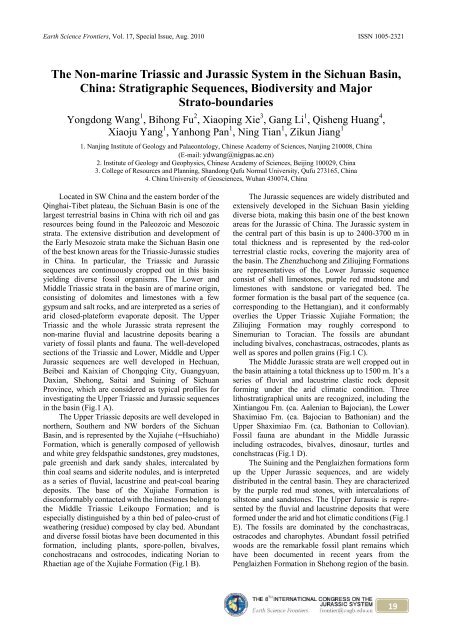in Jurassic and Cretaceous Stratigraphy
in Jurassic and Cretaceous Stratigraphy
in Jurassic and Cretaceous Stratigraphy
Create successful ePaper yourself
Turn your PDF publications into a flip-book with our unique Google optimized e-Paper software.
Earth Science Frontiers, Vol. 17, Special Issue, Aug. 2010 ISSN 1005-2321<br />
The Non-mar<strong>in</strong>e Triassic <strong>and</strong> <strong>Jurassic</strong> System <strong>in</strong> the Sichuan Bas<strong>in</strong>,<br />
Ch<strong>in</strong>a: Stratigraphic Sequences, Biodiversity <strong>and</strong> Major<br />
Strato-boundaries<br />
Yongdong Wang 1 , Bihong Fu 2 , Xiaop<strong>in</strong>g Xie 3 , Gang Li 1 , Qisheng Huang 4 ,<br />
Xiaoju Yang 1 , Yanhong Pan 1 , N<strong>in</strong>g Tian 1 , Zikun Jiang 1<br />
1. Nanj<strong>in</strong>g Institute of Geology <strong>and</strong> Palaeontology, Ch<strong>in</strong>ese Academy of Sciences, Nanj<strong>in</strong>g 210008, Ch<strong>in</strong>a<br />
(E-mail: ydwang@nigpas.ac.cn)<br />
2. Institute of Geology <strong>and</strong> Geophysics, Ch<strong>in</strong>ese Academy of Sciences, Beij<strong>in</strong>g 100029, Ch<strong>in</strong>a<br />
3. College of Resources <strong>and</strong> Plann<strong>in</strong>g, Sh<strong>and</strong>ong Qufu Normal University, Qufu 273165, Ch<strong>in</strong>a<br />
4. Ch<strong>in</strong>a University of Geosciences, Wuhan 430074, Ch<strong>in</strong>a<br />
Located <strong>in</strong> SW Ch<strong>in</strong>a <strong>and</strong> the eastern border of the<br />
Q<strong>in</strong>ghai-Tibet plateau, the Sichuan Bas<strong>in</strong> is one of the<br />
largest terrestrial bas<strong>in</strong>s <strong>in</strong> Ch<strong>in</strong>a with rich oil <strong>and</strong> gas<br />
resources be<strong>in</strong>g found <strong>in</strong> the Paleozoic <strong>and</strong> Mesozoic<br />
strata. The extensive distribution <strong>and</strong> development of<br />
the Early Mesozoic strata make the Sichuan Bas<strong>in</strong> one<br />
of the best known areas for the Triassic-<strong>Jurassic</strong> studies<br />
<strong>in</strong> Ch<strong>in</strong>a. In particular, the Triassic <strong>and</strong> <strong>Jurassic</strong><br />
sequences are cont<strong>in</strong>uously cropped out <strong>in</strong> this bas<strong>in</strong><br />
yield<strong>in</strong>g diverse fossil organisms. The Lower <strong>and</strong><br />
Middle Triassic strata <strong>in</strong> the bas<strong>in</strong> are of mar<strong>in</strong>e orig<strong>in</strong>,<br />
consist<strong>in</strong>g of dolomites <strong>and</strong> limestones with a few<br />
gypsum <strong>and</strong> salt rocks, <strong>and</strong> are <strong>in</strong>terpreted as a series of<br />
arid closed-plateform evaporate deposit. The Upper<br />
Triassic <strong>and</strong> the whole <strong>Jurassic</strong> strata represent the<br />
non-mar<strong>in</strong>e fluvial <strong>and</strong> lacustr<strong>in</strong>e deposits bear<strong>in</strong>g a<br />
variety of fossil plants <strong>and</strong> fauna. The well-developed<br />
sections of the Triassic <strong>and</strong> Lower, Middle <strong>and</strong> Upper<br />
<strong>Jurassic</strong> sequences are well developed <strong>in</strong> Hechuan,<br />
Beibei <strong>and</strong> Kaixian of Chongq<strong>in</strong>g City, Guangyuan,<br />
Daxian, Shehong, Saitai <strong>and</strong> Su<strong>in</strong><strong>in</strong>g of Sichuan<br />
Prov<strong>in</strong>ce, which are considered as typical profiles for<br />
<strong>in</strong>vestigat<strong>in</strong>g the Upper Triassic <strong>and</strong> <strong>Jurassic</strong> sequences<br />
<strong>in</strong> the bas<strong>in</strong> (Fig.1 A).<br />
The Upper Triassic deposits are well developed <strong>in</strong><br />
northern, Southern <strong>and</strong> NW borders of the Sichuan<br />
Bas<strong>in</strong>, <strong>and</strong> is represented by the Xujiahe (=Hsuchiaho)<br />
Formation, which is generally composed of yellowish<br />
<strong>and</strong> white grey feldspathic s<strong>and</strong>stones, grey mudstones,<br />
pale greenish <strong>and</strong> dark s<strong>and</strong>y shales, <strong>in</strong>tercalated by<br />
th<strong>in</strong> coal seams <strong>and</strong> siderite nodules, <strong>and</strong> is <strong>in</strong>terpreted<br />
as a series of fluvial, lacustr<strong>in</strong>e <strong>and</strong> peat-coal bear<strong>in</strong>g<br />
deposits. The base of the Xujiahe Formation is<br />
disconformably contacted with the limestones belong to<br />
the Middle Triassic Leikoupo Formation; <strong>and</strong> is<br />
especially dist<strong>in</strong>guished by a th<strong>in</strong> bed of paleo-crust of<br />
weather<strong>in</strong>g (residue) composed by clay bed. Abundant<br />
<strong>and</strong> diverse fossil biotas have been documented <strong>in</strong> this<br />
formation, <strong>in</strong>clud<strong>in</strong>g plants, spore-pollen, bivalves,<br />
conchostracans <strong>and</strong> ostrocodes, <strong>in</strong>dicat<strong>in</strong>g Norian to<br />
Rhaetian age of the Xujiahe Formation (Fig.1 B).<br />
The <strong>Jurassic</strong> sequences are widely distributed <strong>and</strong><br />
extensively developed <strong>in</strong> the Sichuan Bas<strong>in</strong> yield<strong>in</strong>g<br />
diverse biota, mak<strong>in</strong>g this bas<strong>in</strong> one of the best known<br />
areas for the <strong>Jurassic</strong> of Ch<strong>in</strong>a. The <strong>Jurassic</strong> system <strong>in</strong><br />
the central part of this bas<strong>in</strong> is up to 2400-3700 m <strong>in</strong><br />
total thickness <strong>and</strong> is represented by the red-color<br />
terrestrial clastic rocks, cover<strong>in</strong>g the majority area of<br />
the bas<strong>in</strong>. The Zhenzhuchong <strong>and</strong> Ziliuj<strong>in</strong>g Formations<br />
are representatives of the Lower <strong>Jurassic</strong> sequence<br />
consist of shell limestones, purple red mudstone <strong>and</strong><br />
limestones with s<strong>and</strong>stone or variegated bed. The<br />
former formation is the basal part of the sequence (ca.<br />
correspond<strong>in</strong>g to the Hettangian), <strong>and</strong> it conformably<br />
overlies the Upper Triassic Xujiahe Formation; the<br />
Ziliuj<strong>in</strong>g Formation may roughly correspond to<br />
S<strong>in</strong>emurian to Toracian. The fossils are abundant<br />
<strong>in</strong>clud<strong>in</strong>g bivalves, conchastracas, ostracodes, plants as<br />
well as spores <strong>and</strong> pollen gra<strong>in</strong>s (Fig.1 C).<br />
The Middle <strong>Jurassic</strong> strata are well cropped out <strong>in</strong><br />
the bas<strong>in</strong> atta<strong>in</strong><strong>in</strong>g a total thickness up to 1500 m. It’s a<br />
series of fluvial <strong>and</strong> lacustr<strong>in</strong>e clastic rock deposit<br />
form<strong>in</strong>g under the arid climatic condition. Three<br />
lithostratigraphical units are recognized, <strong>in</strong>clud<strong>in</strong>g the<br />
X<strong>in</strong>tiangou Fm. (ca. Aalenian to Bajocian), the Lower<br />
Shaximiao Fm. (ca. Bajocian to Bathonian) <strong>and</strong> the<br />
Upper Shaximiao Fm. (ca. Bathonian to Collovian).<br />
Fossil fauna are abundant <strong>in</strong> the Middle <strong>Jurassic</strong><br />
<strong>in</strong>clud<strong>in</strong>g ostracodes, bivalves, d<strong>in</strong>osaur, turtles <strong>and</strong><br />
conchstracas (Fig.1 D).<br />
The Su<strong>in</strong><strong>in</strong>g <strong>and</strong> the Penglaizhen formations form<br />
up the Upper <strong>Jurassic</strong> sequences, <strong>and</strong> are widely<br />
distributed <strong>in</strong> the central bas<strong>in</strong>. They are characterized<br />
by the purple red mud stones, with <strong>in</strong>tercalations of<br />
siltstone <strong>and</strong> s<strong>and</strong>stones. The Upper <strong>Jurassic</strong> is repre-<br />
sented by the fluvial <strong>and</strong> lacustr<strong>in</strong>e deposits that were<br />
formed under the arid <strong>and</strong> hot climatic conditions (Fig.1<br />
E). The fossils are dom<strong>in</strong>ated by the conchastracas,<br />
ostracodes <strong>and</strong> charophytes. Abundant fossil petrified<br />
woods are the remarkable fossil plant rema<strong>in</strong>s which<br />
have been documented <strong>in</strong> recent years from the<br />
Penglaizhen Formation <strong>in</strong> Shehong region of the bas<strong>in</strong>.<br />
19

















